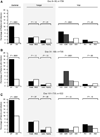Timeline, epidemiology, and risk factors for bacterial, fungal, and viral infections in children and adolescents after allogeneic hematopoietic stem cell transplantation
- PMID: 22922523
- PMCID: PMC3554248
- DOI: 10.1016/j.bbmt.2012.08.012
Timeline, epidemiology, and risk factors for bacterial, fungal, and viral infections in children and adolescents after allogeneic hematopoietic stem cell transplantation
Abstract
Advances made in the field of hematopoietic stem cell transplantations (HSCT) over the past 20 years may have had an impact on the distribution of posttransplantation infections. We sought to retrospectively analyze the epidemiology and risk factors for bacterial, fungal, and viral infections in children after allogeneic HSCT in a cohort of 759 children who underwent allogeneic HSCT in a single institution between 1990 and 2009. The association between infections and risk factors of interest at 0 to 30 days, 31 to 100 days, and 101 days to 2 years posttransplantation was evaluated using logistic regression. Difference among the subtypes within each category was studied. There were 243 matched-related donors, 239 matched-unrelated donors (MUDs), and 176 haploidentical donor transplantations. Era of transplantation (0-30 days), peripheral blood stem cell product, acute graft-versus-host disease (aGVHD; 31-100 days), and chronic GVHD (cGVHD; 101-730 days) were associated with higher risk for bacterial infections at the respective time periods. Patients with aGVHD (31-100 days), cGVHD, and older age (101-730 days) were at higher risk for fungal infections. Cytomegalovirus (CMV) donor/recipient (D/R) serostatus (0-100 days), era of transplantation, MUD HSCT (31-100 days), and cGVHD (101-730 days), influenced viral infections. Gram-positive outnumbered gram-negative bacterial infections; aspergillosis and candidemia were equally prevalent in all time periods. Haploidentical donor HSCT was not associated with an increased risk of infections. There seems to be a continuum in the timeline of infections posttransplantation, with bacterial, fungal, and viral infections prevalent in all time periods, particularly late after the transplantation, the risk affected by GVHD, CMV, D/R status, product type, older age, and use of unrelated donors.
Copyright © 2013 American Society for Blood and Marrow Transplantation. Published by Elsevier Inc. All rights reserved.
Conflict of interest statement
Figures

References
-
- Collin BA, Leather HL, Wingard JR, Ramphal R. Evolution, incidence, and susceptibility of bacterial bloodstream isolates from 519 bone marrow transplant patients. Clin Infect Dis. 2001;33:947–953. - PubMed
-
- Kontoyiannis DP, Marr KA, Park BJ, et al. Prospective surveillance for invasive fungal infections in hematopoietic stem cell recipients, 2001–2006: overview of the Transplant-Associated Infection Surveillance Network (TRANSNET) database. Clin Infect Dis. 2010;50:1091–1100. - PubMed
-
- Boeckh M, Leisenring W, Riddell SR, et al. Late cytomegalovirus disease and mortality in recipients of allogeneic hematopoietic stem cell transplants: importance of viral load and T-cell immunity. Blood. 2003;101:407–414. - PubMed
-
- Ljungman P, Perez-Bercoff L, Jonsson J, et al. Risk factors for the development of cytomegalovirus disease after allogeneic stem cell transplantation. Haematologica. 2006;91:78–83. - PubMed
Publication types
MeSH terms
Grants and funding
LinkOut - more resources
Full Text Sources
Other Literature Sources
Medical
Miscellaneous

